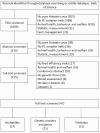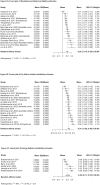Unveiling the Genetic Landscape of Feed Efficiency in Holstein Dairy Cows: Insights into Heritability, Genetic Markers, and Pathways via Meta-Analysis
- PMID: 38354297
- PMCID: PMC10957122
- DOI: 10.1093/jas/skae040
Unveiling the Genetic Landscape of Feed Efficiency in Holstein Dairy Cows: Insights into Heritability, Genetic Markers, and Pathways via Meta-Analysis
Abstract
Improving the feeding efficiency of dairy cows is a key component to improve the utilization of land resources and meet the demand for high-quality protein. Advances in genomic methods and omics techniques have made it possible to breed more efficient dairy cows through genomic selection. The aim of this review is to obtain a comprehensive understanding of the biological background of feed efficiency (FE) complex traits in purebred Holstein dairy cows including heritability estimate, and genetic markers, genes, and pathways participating in FE regulation mechanism. Through a literature search, we systematically reviewed the heritability estimation, molecular genetic markers, genes, biomarkers, and pathways of traits related to feeding efficiency in Holstein dairy cows. A meta-analysis based on a random-effects model was performed to combine reported heritability estimates of FE complex. The heritability of residual feed intake, dry matter intake, and energy balance was 0.20, 0.34, and 0.22, respectively, which proved that it was reasonable to include the related traits in the selection breeding program. For molecular genetic markers, a total of 13 single-nucleotide polymorphisms and copy number variance loci, associated genes, and functions were reported to be significant across populations. A total of 169 reported candidate genes were summarized on a large scale, using a higher threshold (adjusted P value < 0.05). Then, the subsequent pathway enrichment of these genes was performed. The important genes reported in the articles were included in a gene list and the gene list was enriched by gene ontology (GO):biological process (BP), and Kyoto Encyclopedia of Genes and Genomes (KEGG) pathways analysis. Three GO:BP terms and four KEGG terms were statistically significant, which mainly focused on adenosine triphosphate (ATP) synthesis, electron transport chain, and OXPHOS pathway. Among these pathways, involved genes such as ATP5MC2, NDUFA, COX7A2, UQCR, and MMP are particularly important as they were previously reported. Twenty-nine reported biological mechanisms along with involved genes were explained mainly by four biological pathways (insulin-like growth factor axis, lipid metabolism, oxidative phosphorylation pathways, tryptophan metabolism). The information from this study will be useful for future studies of genomic selection breeding and genetic structures influencing animal FE. A better understanding of the underlying biological mechanisms would be beneficial, particularly as it might address genetic antagonism.
Keywords: Holstein dairy cows; feed efficiency; genetic factors; heritability; pathway analysis.
Plain language summary
A thorough understanding of the genetic factors that influence the feed efficiency of dairy cows is a prerequisite for planning and implementing selective breeding programs. Therefore, a systematic review of reported heritability, genetic markers, and biological pathways affecting FE-related traits in Holstein dairy cows was conducted and followed by a meta-analysis. A total of 47 articles were refined after literature screening and were presented in this review. A meta-analysis based on a random-effects model was then performed to combine the heritability estimates from studies. The meta-analysis showed heritability estimates of residual feed intake, dry matter intake, and energy balance were 0.22, 0.34, and 0.24, respectively. The systematic review demonstrated that 169 significant candidate genes, 13 genetic markers, and 29 biological mechanisms were previously reported on FE in Holstein dairy cows. Involved candidate genes and biological mechanisms are presented mainly in four biological mechanisms (insulin-like growth factors axis, lipid metabolism, oxidative phosphorylation pathways, tryptophan metabolism). The meta-analysis of the reported candidate genes showed three statistically significant KEGG terms and four GO:BP terms, which mainly focused on ATP synthesis, electron transport chain, and OXPHOS pathway.
© The Author(s) 2024. Published by Oxford University Press on behalf of the American Society of Animal Science.
Figures


Similar articles
-
High-density genome-wide association study for residual feed intake in Holstein dairy cattle.J Dairy Sci. 2019 Dec;102(12):11067-11080. doi: 10.3168/jds.2019-16645. Epub 2019 Sep 25. J Dairy Sci. 2019. PMID: 31563317
-
The genetic and biological basis of feed efficiency in mid-lactation Holstein dairy cows.J Dairy Sci. 2017 Nov;100(11):9061-9075. doi: 10.3168/jds.2017-12604. Epub 2017 Aug 23. J Dairy Sci. 2017. PMID: 28843688
-
Reliability of breeding values for feed intake and feed efficiency traits in dairy cattle: When dry matter intake recordings are sparse under different scenarios.J Dairy Sci. 2019 Aug;102(8):7248-7262. doi: 10.3168/jds.2018-16020. Epub 2019 May 31. J Dairy Sci. 2019. PMID: 31155258
-
Cell Biology Symposium: genetics of feed efficiency in dairy and beef cattle.J Anim Sci. 2013 Apr;91(4):1594-613. doi: 10.2527/jas.2012-5862. Epub 2013 Jan 23. J Anim Sci. 2013. PMID: 23345557 Review.
-
Invited review: improving feed efficiency in dairy production: challenges and possibilities.Animal. 2015 Mar;9(3):395-408. doi: 10.1017/S1751731114002997. Epub 2014 Dec 8. Animal. 2015. PMID: 25482927 Review.
Cited by
-
Assessment of Genetic Diversity and Productive Traits in Crossbreed Cattle in the Caribbean Region, Colombia.Genes (Basel). 2025 May 30;16(6):677. doi: 10.3390/genes16060677. Genes (Basel). 2025. PMID: 40565569 Free PMC article.
-
Metabolism and immune responses of striped hamsters to ectoparasite challenges: insights from transcriptomic analysis.Front Immunol. 2024 Dec 12;15:1516382. doi: 10.3389/fimmu.2024.1516382. eCollection 2024. Front Immunol. 2024. PMID: 39723213 Free PMC article.
-
Approaches for predicting dairy cattle methane emissions: from traditional methods to machine learning.J Anim Sci. 2024 Jan 3;102:skae219. doi: 10.1093/jas/skae219. J Anim Sci. 2024. PMID: 39123286 Free PMC article.
References
-
- Abu-Libdeh, B., Douiev L., Amro S., Shahrour M., Ta-Shma A., Miller C., Elpeleg O., and Saada A... 2017. Mutation in the COX4I1 gene is associated with short stature, poor weight gain and increased chromosomal breaks, simulating Fanconi anemia. Eur. J. Human Genet. 25:1142–1146. doi:10.1038/ejhg.2017.112 - DOI - PMC - PubMed
Publication types
MeSH terms
Substances
Grants and funding
LinkOut - more resources
Full Text Sources

